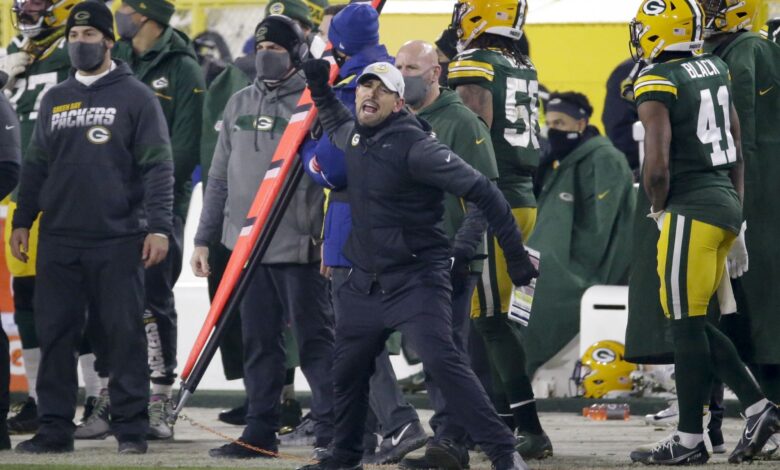Packers, Bills analytics need retooling after field goals

[ad_1]
As Kansas City and Tampa Bay prepare for the Super Bowl on Feb. 7, they leave behind a parade of playoff casualties who in this era of analytics have been doomed by errors of analytics.
Whatever algorithm NFL teams are using in an admirable attempt to replace passion and gut feelings from critical in-game decisions needs to be recalculated to consider variables that may not factor into a math equation.
Consider that in the 2020 playoffs, Patrick Mahomes has quarterbacked 15 Kansas City offensive drives. Those have resulted in seven touchdowns, four field goals, one missed field goal and one punt. There have been two others where Mahomes took a knee to run out the clock.
He’s essentially unstoppable, a knockout artist that you just aren’t going to beat with 12 rounds of jabs. At some point, you have to stand and fight.
Yet twice in Sunday’s AFC championship game, Buffalo faced fourth-and-short inside the Kansas City 10-yard line only to have coach Sean McDermott choose to kick field goals rather than let his young star quarterback, Josh Allen, try to potentially score a touchdown.
The Bills converted both kicks and kept the score “close” or at least “closer.” In doing so, though, they brought a BB gun to a shootout … with Mahomes on the opposing trigger.
“If I had to do it over again, I’d probably go for one of them,” McDermott conceded after Kansas City won, 38-24.
He should have gone for both of them.
In the NFC championship game, Green Bay trailed Tampa 31-23 with 2:28 remaining in the game. The Packers were set up with first-and-goal from the Bucs’ 8-yard line. Aaron Rodgers threw three consecutive incomplete passes. Then on fourth and goal, coach Matt LaFleur sent in the kicking team, who made it 31-26.
He chose to not give Rodgers, the league’s presumptive MVP, another shot at the end zone. Or, more importantly, he didn’t play the series with the intent to use all four downs rather just three, and thus use run plays or short passes at some point.
LaFleur counted on his defense to get a stop with enough time left to get the ball back to Rodgers to still lead a touchdown score drive and win the game.
Except the Bucs had Tom Brady, the greatest winner in NFL history. He got a couple first downs and closed out the game and advanced to his 10th Super Bowl.
“Any time it doesn’t work out, you always regret it,” LaFleur said.
McDermott and LaFleur are smart young coaches. So is Cleveland’s Kevin Stefanski, who a week prior punted the ball to Kansas City late in the fourth quarter, counting on a defensive stop that never came. Or Tennessee’s Mike Vrabel, who earlier in the playoffs punted on fourth-and-2 from the Baltimore’s 40 only to watch Lamar Jackson grind out nearly six minutes of clock and a lead-extending field goal en route to a Ravens victory.
For the most part, analytics have made football better – coaches are more willing to do smart things like going for it on fourth down. And somewhere the math, if twisted enough, can justify all of the above choices.
Yet whatever data they are putting into the equation apparently miss the most important strategic development in this offense-dominant age: don’t give up the ball.
This isn’t your grandfather’s NFL, where field position was a big deal and avoiding risk was paramount. The first 25 NFC championship games of the Super Bowl era averaged 32.0 total points. The last seven: 55.3.
There is no room for the timid in these playoffs. You have to score. It’s why the numbers have diminishing value.
You can certainly make a case that backs LaFleur. Fourth-and-goal from the 8 is a low-percentage play. The Packers still needed a two-point conversion just to tie. Then they’d need to stop Tampa to get to overtime, where a coin flip or other developments factor in.
Percentage-wise, if one decision factors in the next 10 decisions, LaFleur might be right. (This was a split decision; there are other numbers that say go for it and no one knows what the Packers use.)
Common sense is fairly clear, though.
Do the analytics factor in that you have Rodgers or Allen? Or that they have Mahomes or Brady, who are not just capable of moving the ball but will run aggressive offenses seeking to gain a first down rather than just burn timeouts or clock?
Mostly though, why would you take the game out of the hands of your best player and put into the hands of their best player?
You can argue the Bucs won Sunday because with eight seconds remaining in the first half, they went for it on fourth-and-4 from the Green Bay 39-yard line. Punting was the safe play.
Instead, Brady went to Arians and suggested going for it. Arians was smart enough to ignore the numbers and listen to the guy who has won six Super Bowls.
“I loved it,” Arians said.
Brady likely knew that Rodgers was going to score a bunch in the second half and every Bucs opportunity was precious. So they risked it for the biscuit, Brady caught Green Bay in a bad matchup and then hit Scotty Miller for a touchdown they’d very much need.
That’s why the question sometimes shifts from math class to the philosophy of modern hip-hop, where everyone knows scared money don’t make no money.
More from Yahoo Sports:
[ad_2]
Source link






